Growing out of my Feral and Invasive Pigments project, Feral Hues on Estuarial Fill brings this practice home to the bioregion I’m rooted in: Mohican land in the heart of the Mahicanituck/Hudson River Watershed. This project page is designed to complement the book Feral Hues: A guide to painting with weeds, released Publication Studio Hudson in March 2023 (and also available from me). The palette I used for the paintings below is made from plant parts collected across a year of research and fieldwork along the post-industrial waterfront of current-day Hudson, New York. From December 2021 to November 2022 (with support from Basilica Hudson and Toolshed), I investigated the weedy plant communities who green land known as the “South Bay.” Part of the Hudson River Estuary (the portion of the river that experiences tidal flows from the ocean) this former marshland was filled to accommodate commerce and industry along the river’s edge (pdf). This manufactured land, built with soil dredged from the river and construction debris, is predicted to flood again in the future as sea levels rise.

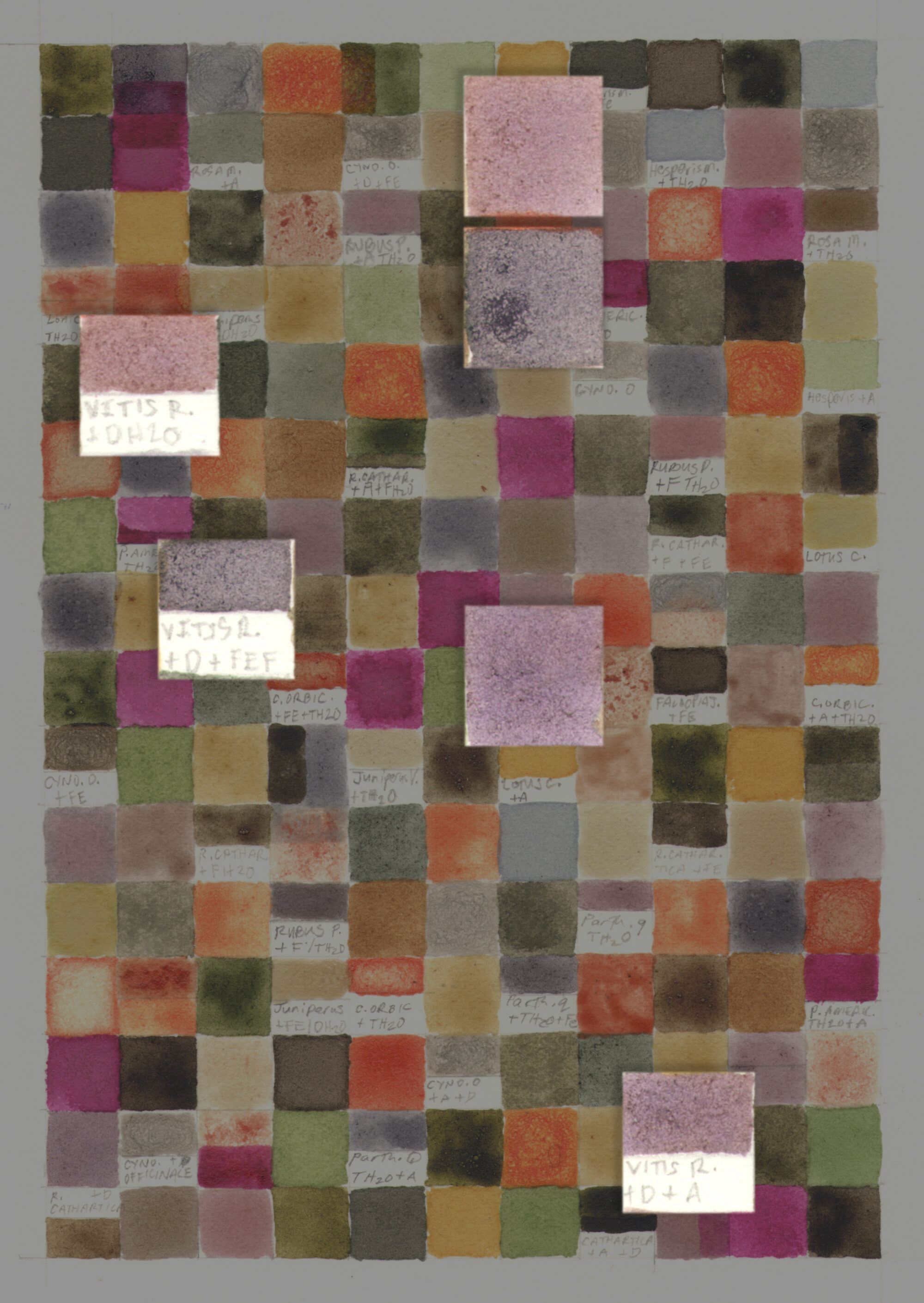

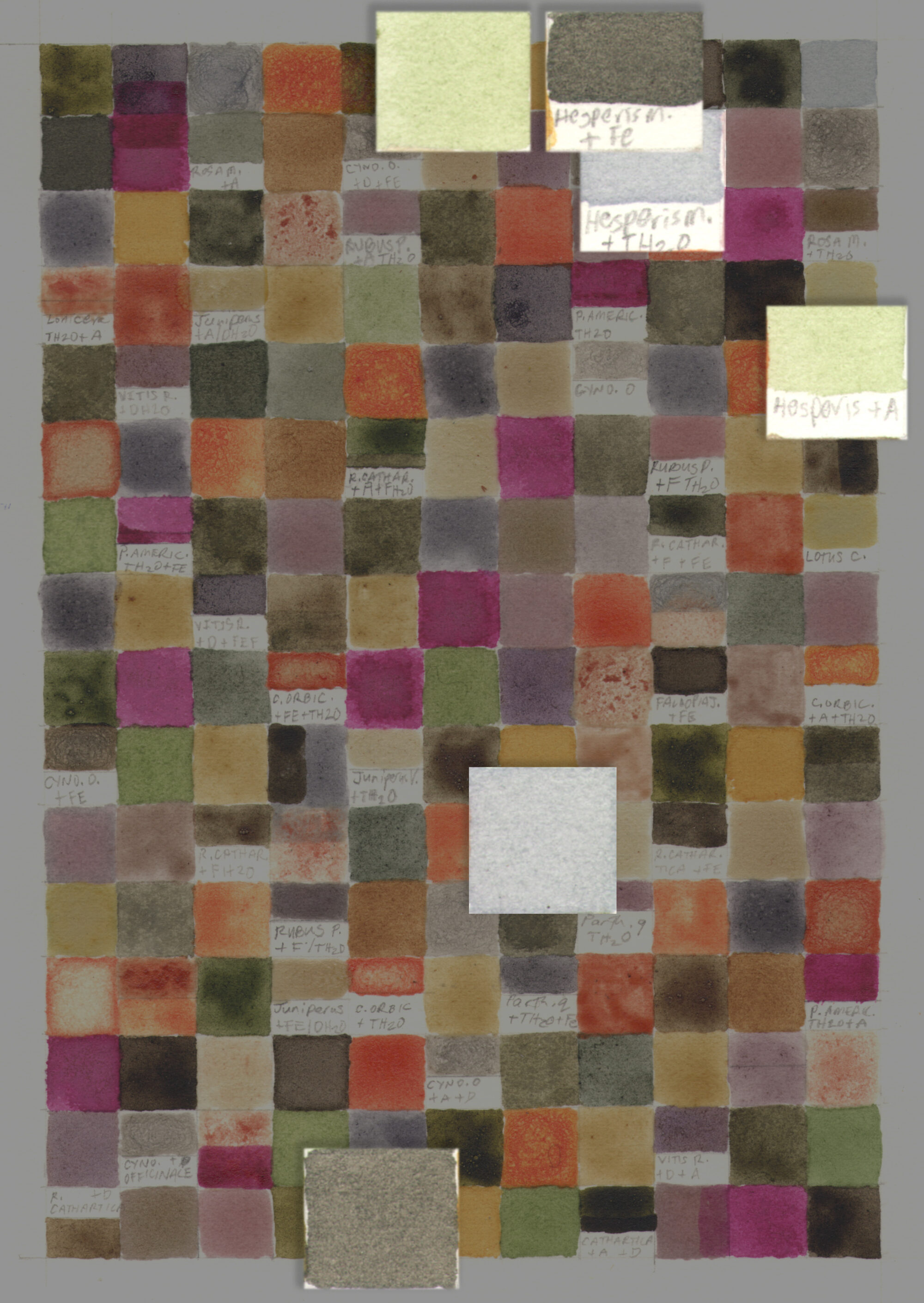

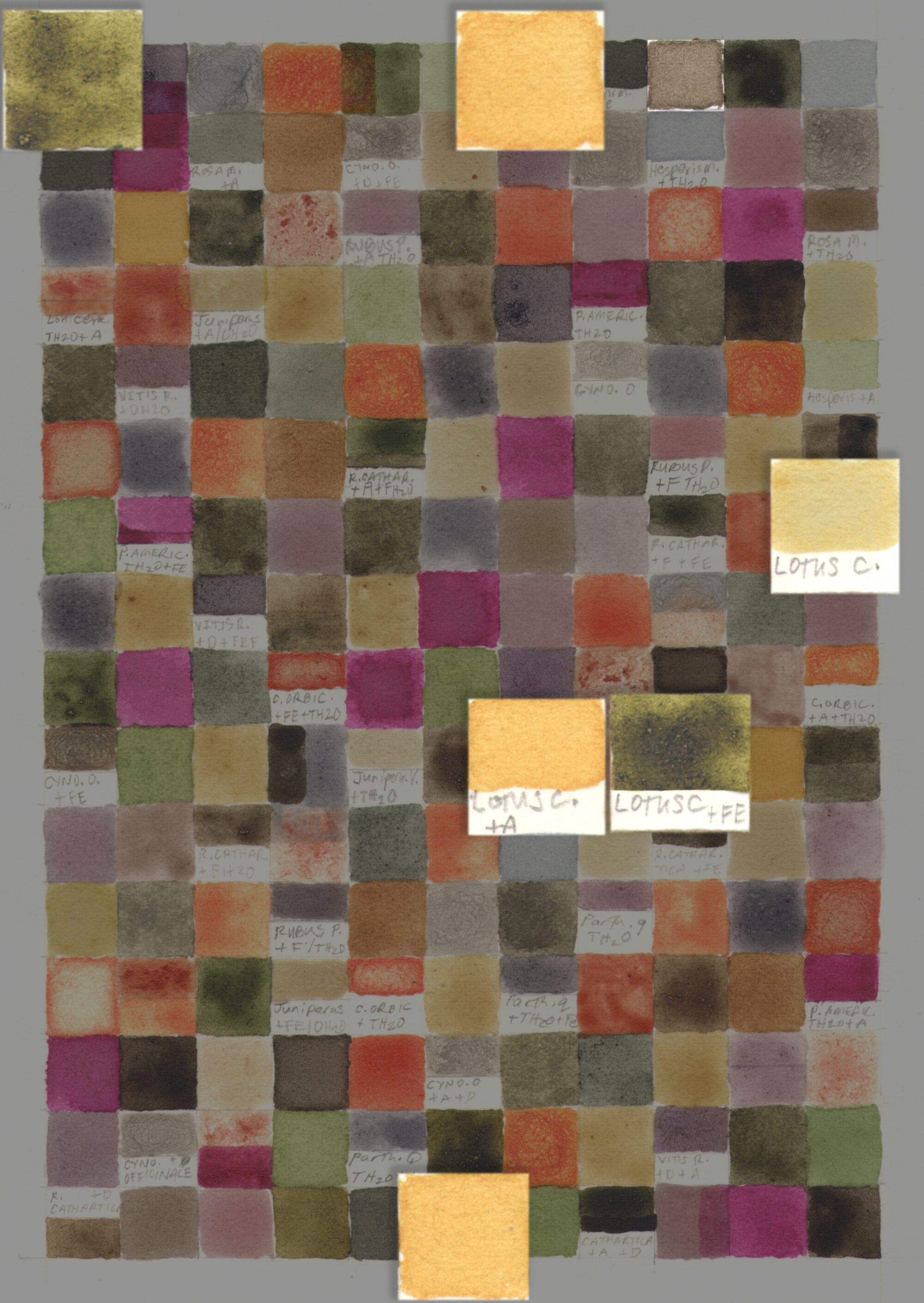



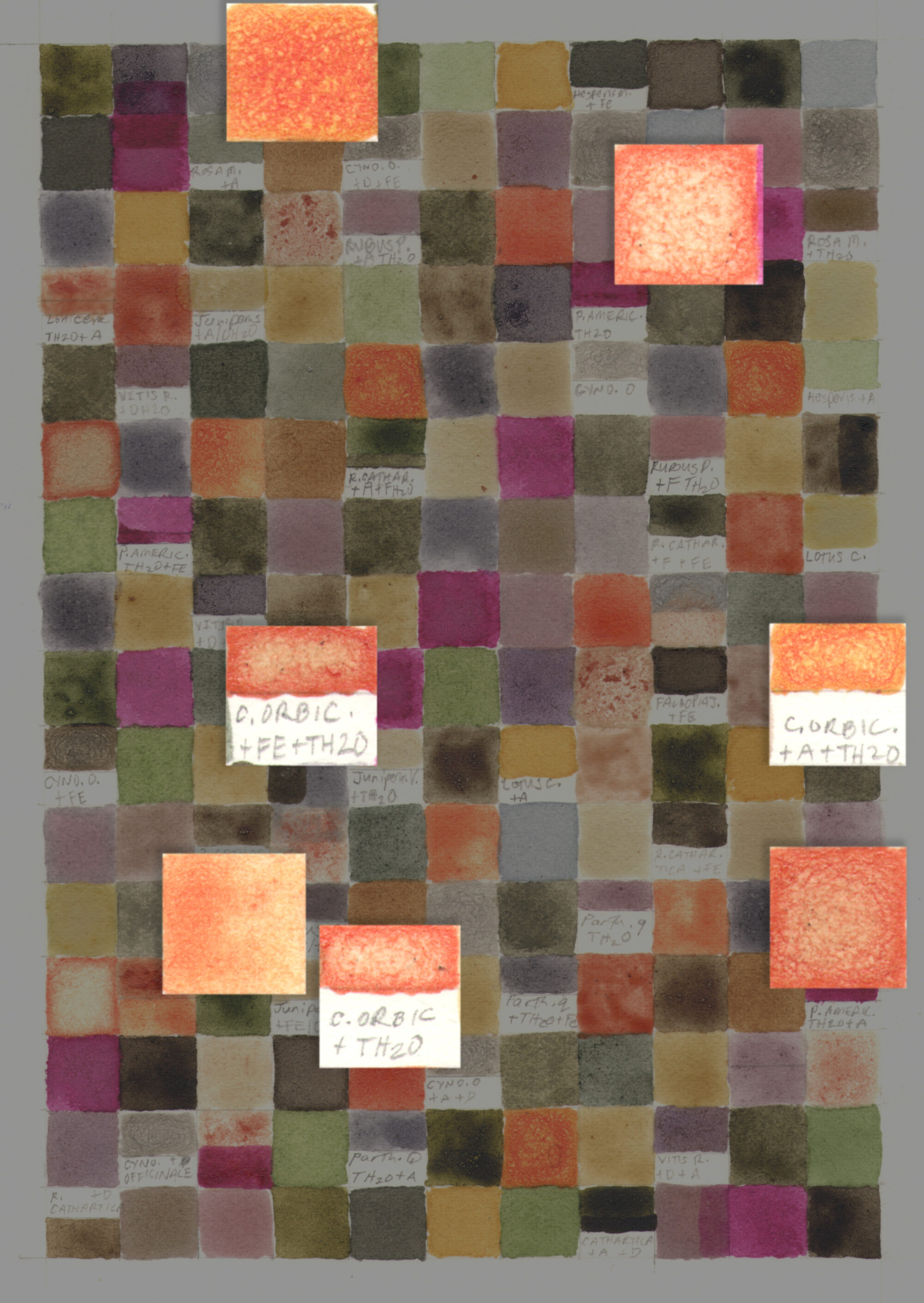

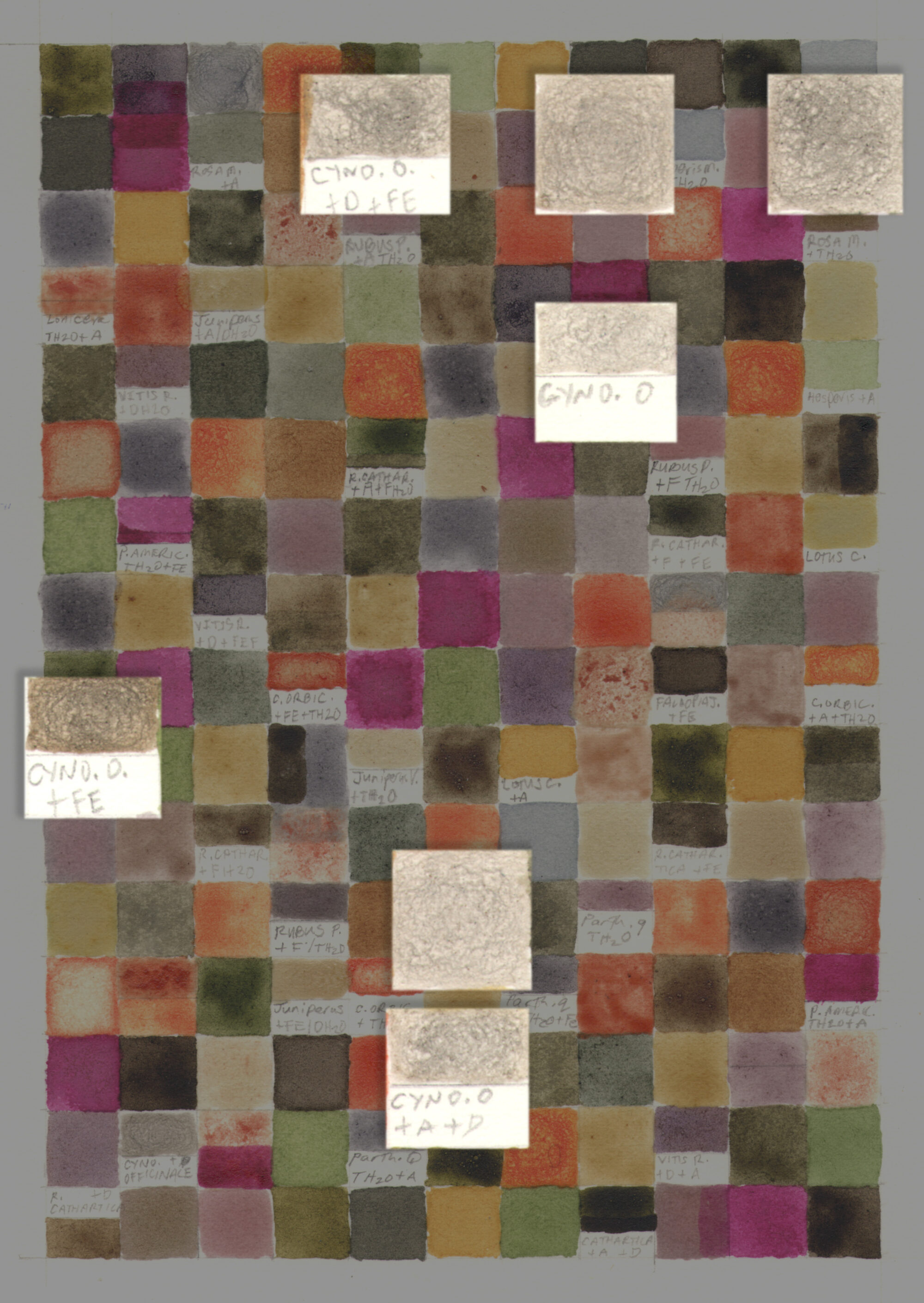

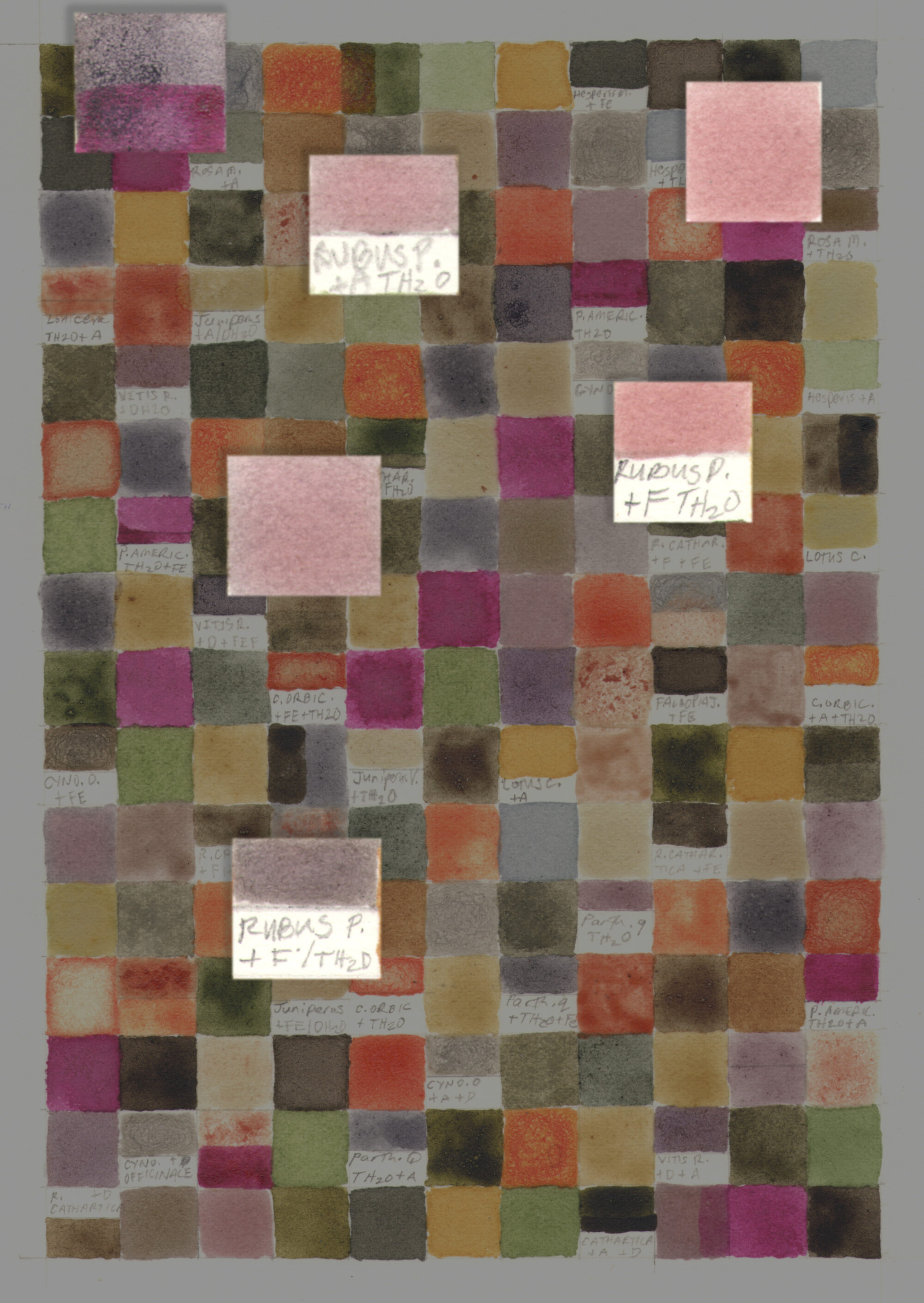

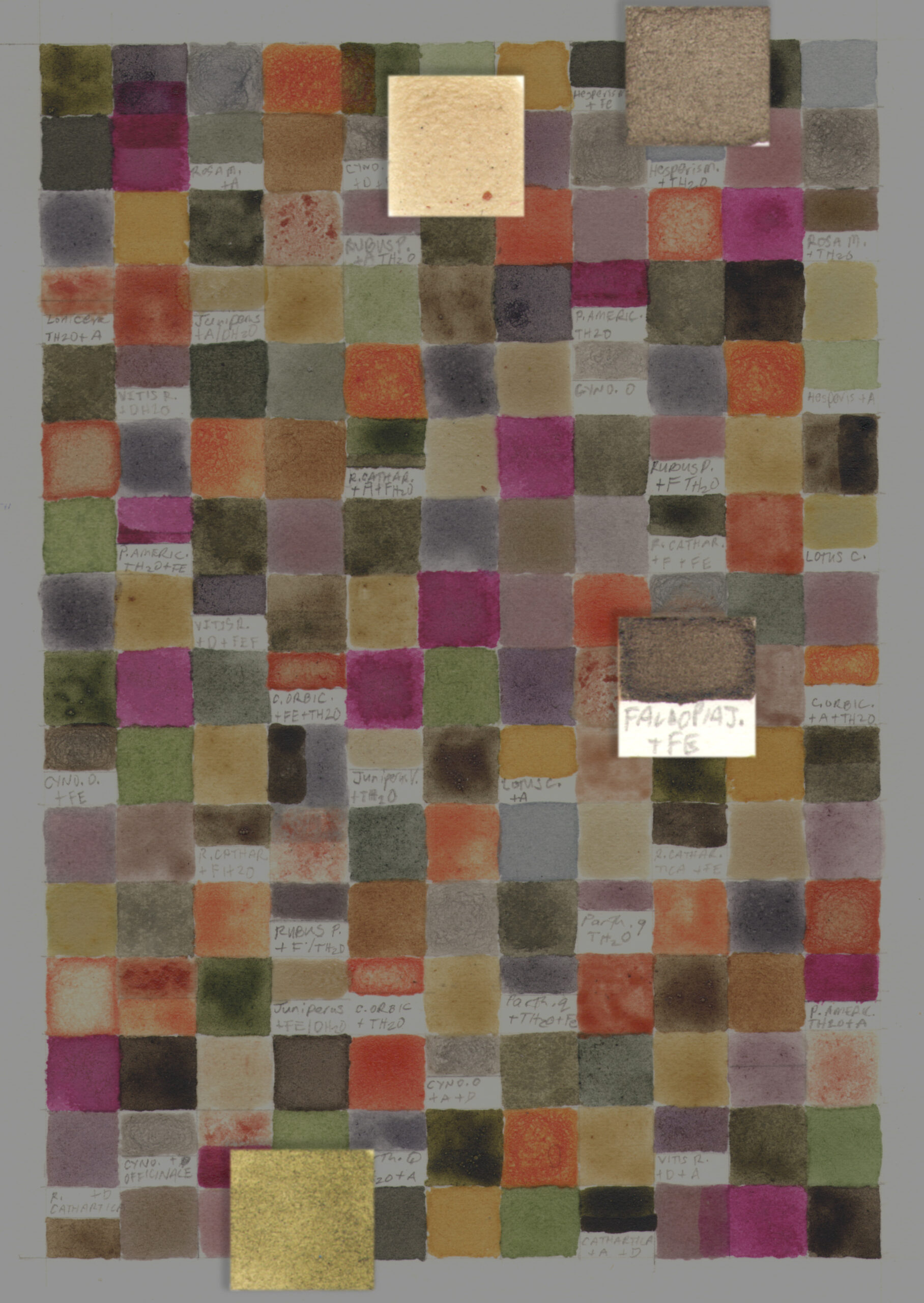




Keep scrolling to learn more about each of the plants I met through my fieldwork in Hudson’s South Bay.
Riverbank grape / Zhawimin / Vitis riparia: climbing liana (vine) with flaky bark and deeply lobed leaves; native to eastern North America; populations also present in western North America and western Europe; thrives in exposed areas and disturbed sites; paints shown here were made from ripe berries, + alum, ferrous sulfate, and various water sources.
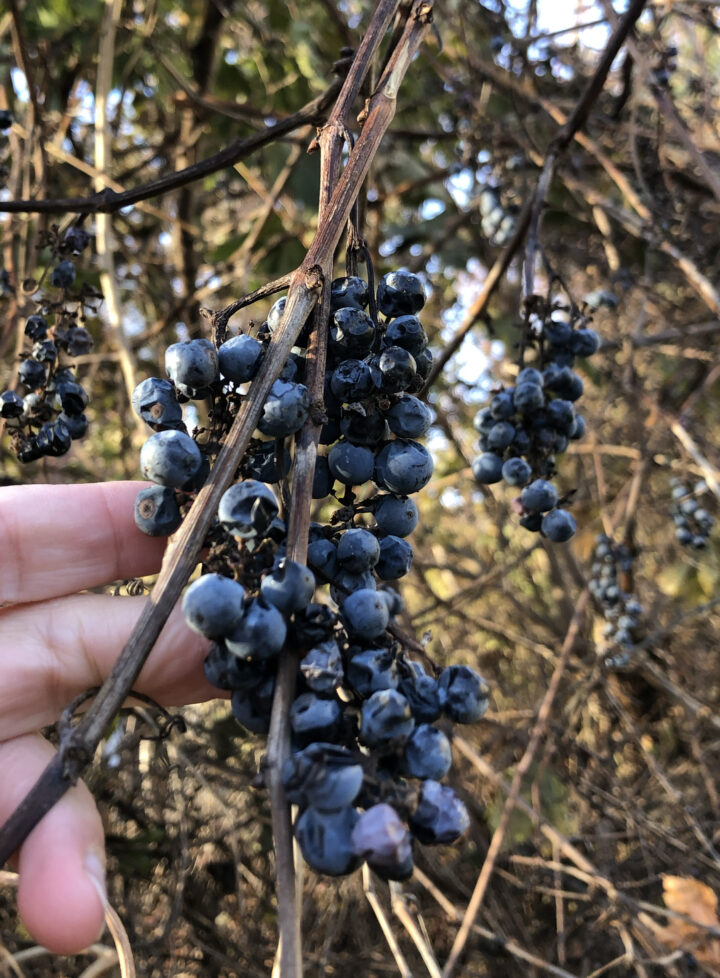 The fruits of riverbank grape stay on the vine well into the winter, making harvests possible for several months
The fruits of riverbank grape stay on the vine well into the winter, making harvests possible for several months
Dames rocket/la julienne des dames/Hesperis matronalis: herbaceous plant with alternate, elongated leaves; grows up to four feet tall; showy four-petaled flowers ranging from white to pink to magenta cluster around a central stalk; evolved in central Asia and Europe, naturalized around the temperate world.
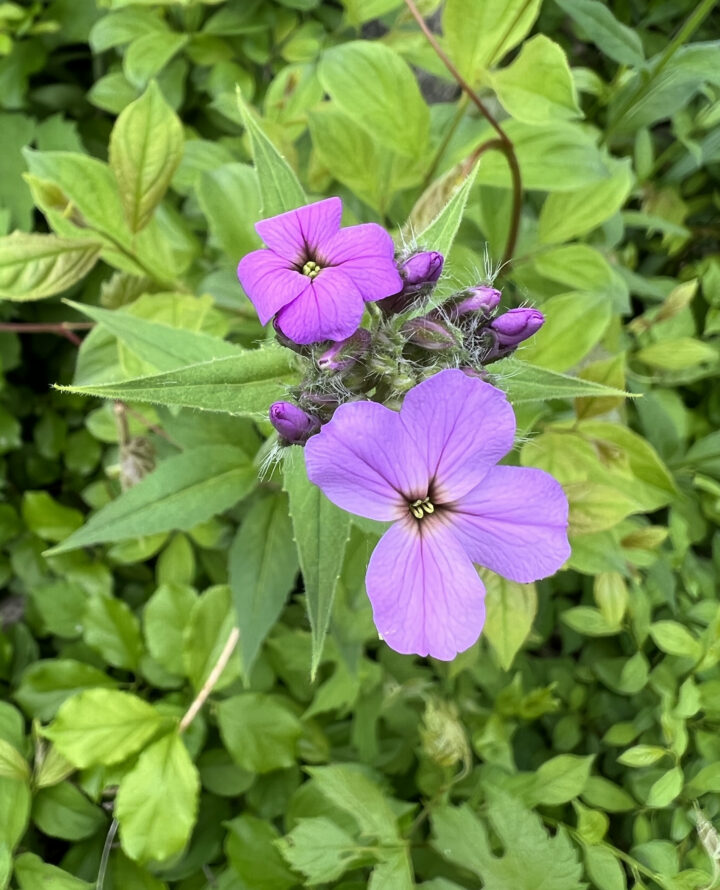 Dame’s rocket growing in a feral meadow in current-day Hudson’s South Bay.
Dame’s rocket growing in a feral meadow in current-day Hudson’s South Bay.
Birdsfoot trefoil / Gazelboynuzu / Lotus corniculatus: mat-forming, low-growing herbaceous perennial; spreads outward from a central root system; native to Southern Europe, Asia, North Africa; naturalized throughout North America; paints pictured here were made with blossoms augmented with alum and ferrous sulfate.
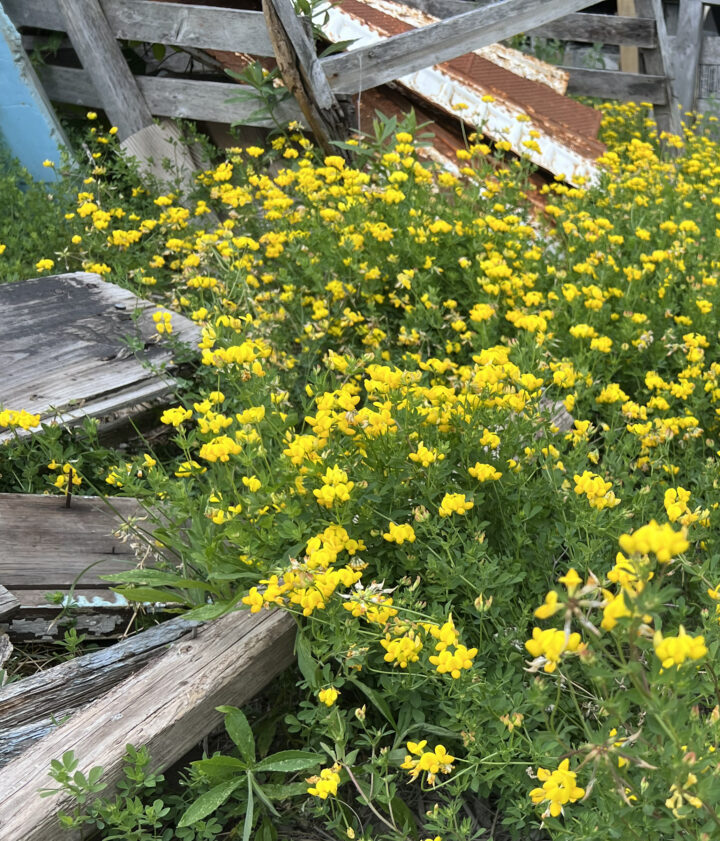
Birdsfoot trefoil greening a debris pile in current-day Hudson’s South Bay.
Pokeweed / pocoon / pèkòn / Phytolacca Americana: bushy perennial plant with long, arching pink/purple stems and large green leaves; forms deep purplish-black berries in late August/early September; evolved in southeastern North America; naturalized around the temperate world; paints shown here were created with ripe berries
 Pokeweed growing on a capped brownfield in current-day Troy, New York.
Pokeweed growing on a capped brownfield in current-day Troy, New York.
Asiatic bittersweet / 蔓梅擬 / Celastrus orbiculatus: climbing vine with shiny green leaves and woody stems; reddish-orange berries encased in yellow pod ripen in autumn; evolved in east Asia, naturalized around the temperate world; paints shown here are made with ripe berries removed from the pod and processed with alum, ferrous sulfate, and tap water (Troy).
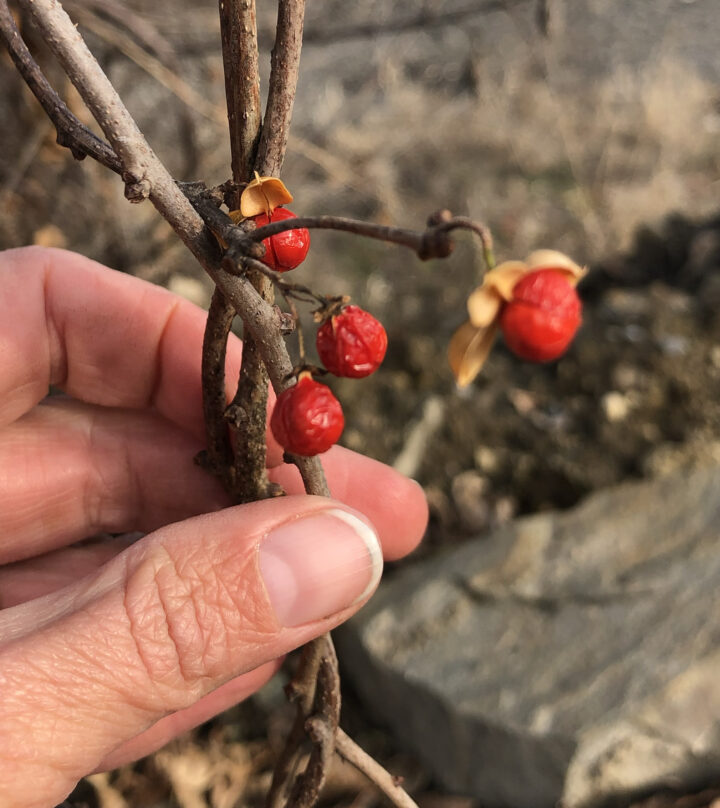 Asiatic bittersweet fruit in winter
Asiatic bittersweet fruit in winter
Hound’s tongue / Cynoglossum officinale: herbaceous biennial or short-lived perennial with deep purple flowers and hairy leaves reminiscent of comfrey; evolved in western Asia and eastern Europe, naturalized throughout temperate North America; paint shown here was made from petals.
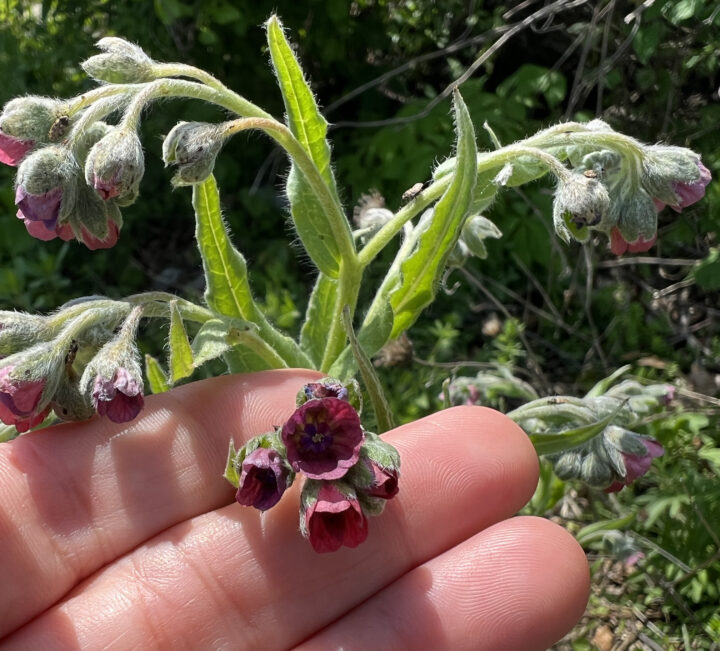 Hound’s tongue growing by the railroad tracks in Hudson’s South Bay, late May.
Hound’s tongue growing by the railroad tracks in Hudson’s South Bay, late May.
Wineberry / Rubus phoenicolasius: thorny vine with dense hairs on canes; close relative of domesticated raspberries and blackberries; native to current-day Japan, China, and Korea, naturalized throughout temperate eastern North America; paint shown here was made with ripe berries and Troy tap water; variations are augmented with alum and ferrous sulfate.
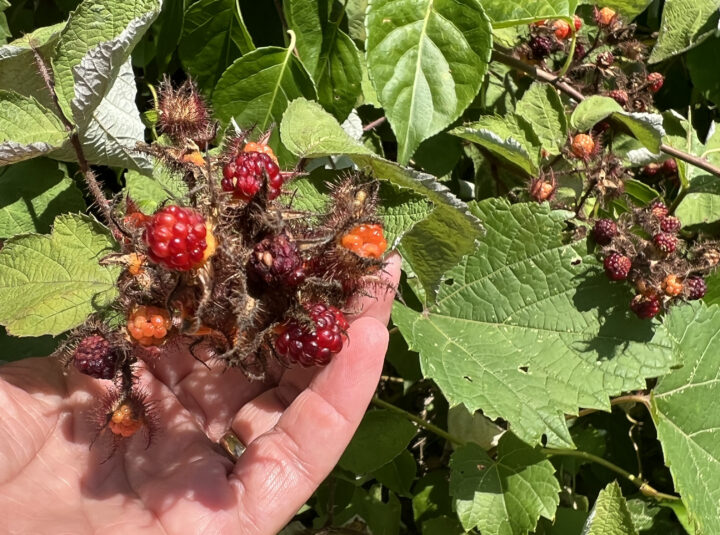
Wineberry entangled with Asiatic Bittersweet and riverside grape in current-day Hudson’s South Bay, July.
Japanese knotweed / itadori / 虎杖 / Reynoutria japonica: rhizome-forming perennial re-sprouts yearly from extensive underground network, forming straight, stout bamboo-like stems; evolved in eastern Asia, naturalized throughout temperate North America; paints shown here were made with young red leaves from emerging shoots; variations include +ferrous sulfate (deep brown) and +alum (pea soup green).
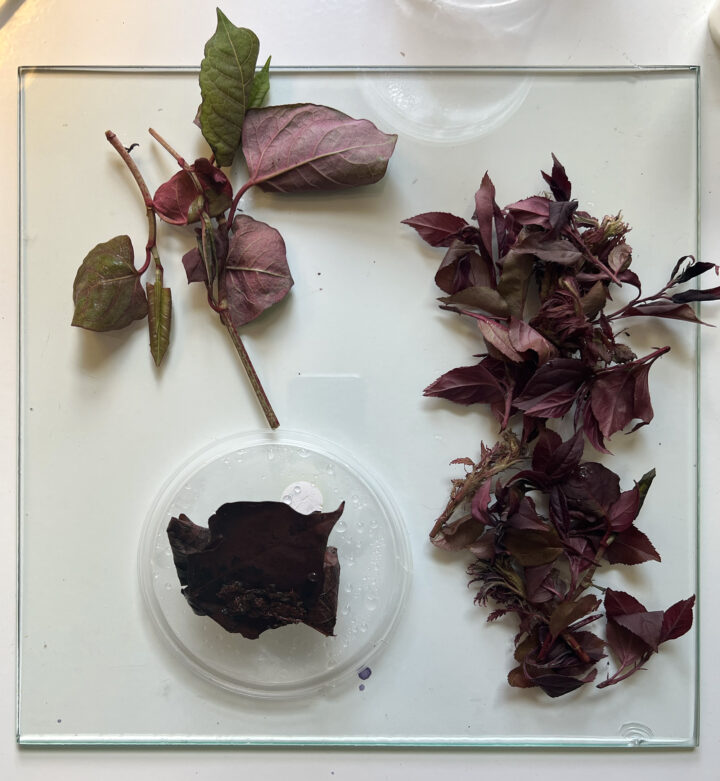
Young knotweed leaves and shoots being prepared for paint-making.
Common buckthorn / Rhamnus cathartica: shrub or small tree with gray bark, thorny branches and shiny black drupes (pit-containing fruit); native to most of Europe and parts of western Asia, naturalized throughout temperate North America with populations concentrated in the eastern portions; paints shown here used ripe berries collected in late fall and early winter, processed with alum (green) and ferrous sulfate (deep brown)
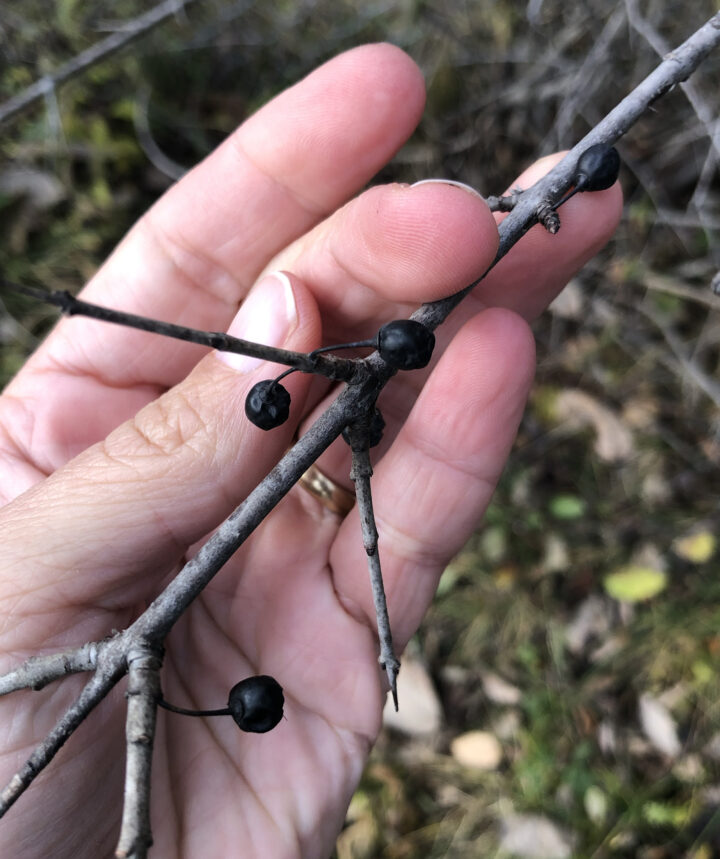 Common buckthorn branch, thorn, and fruit in December.
Common buckthorn branch, thorn, and fruit in December.
Continue scrolling to see more art work made with the paints in this palette.
I used colors in the palette above to create several paintings. The one below takes its shape from the municipal boundaries of current-day Hudson. Embedded in the street grid and shoreline are portraits of the feral plants who green the city’s margins, sidewalk cracks, and abandoned infrastructure.
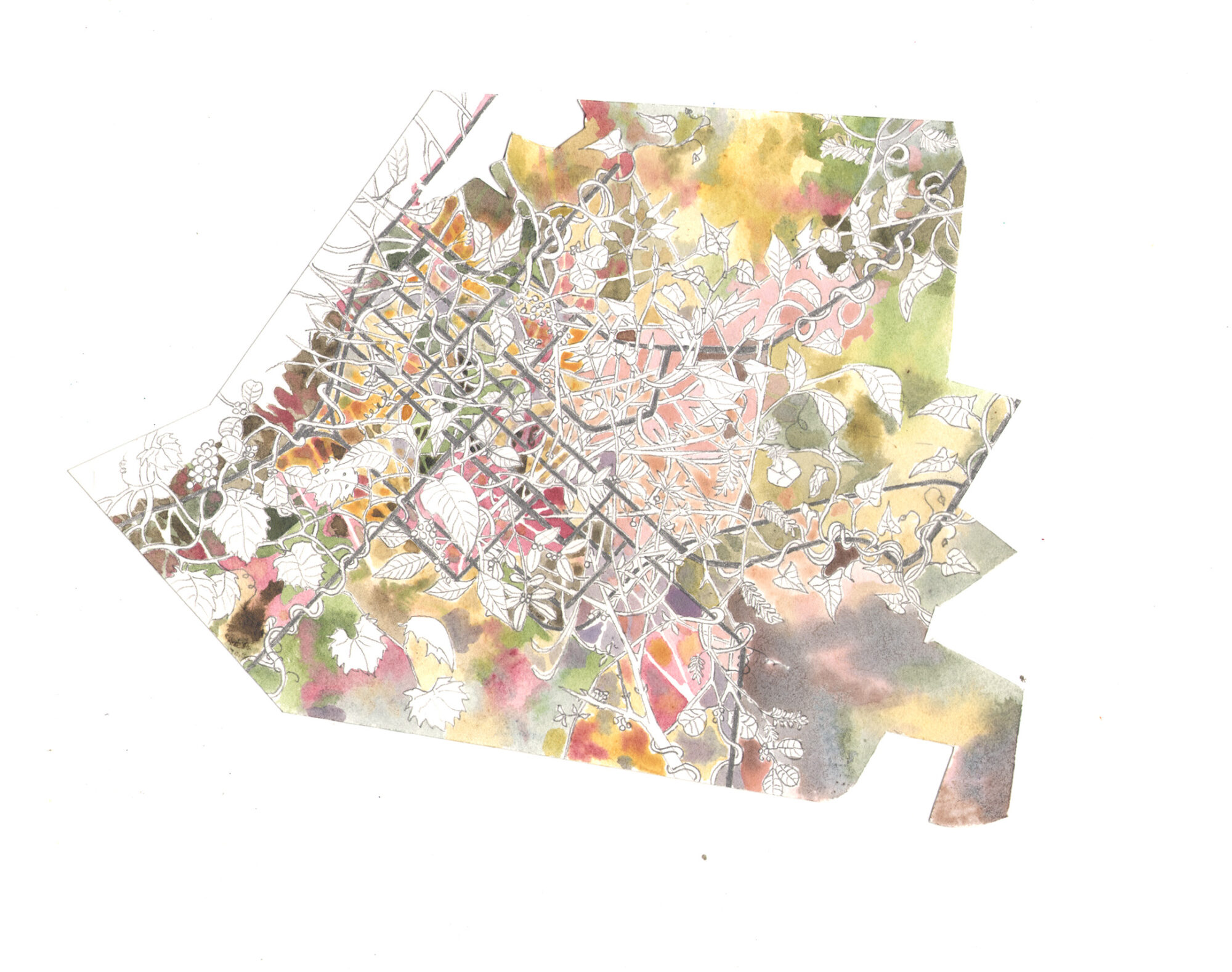
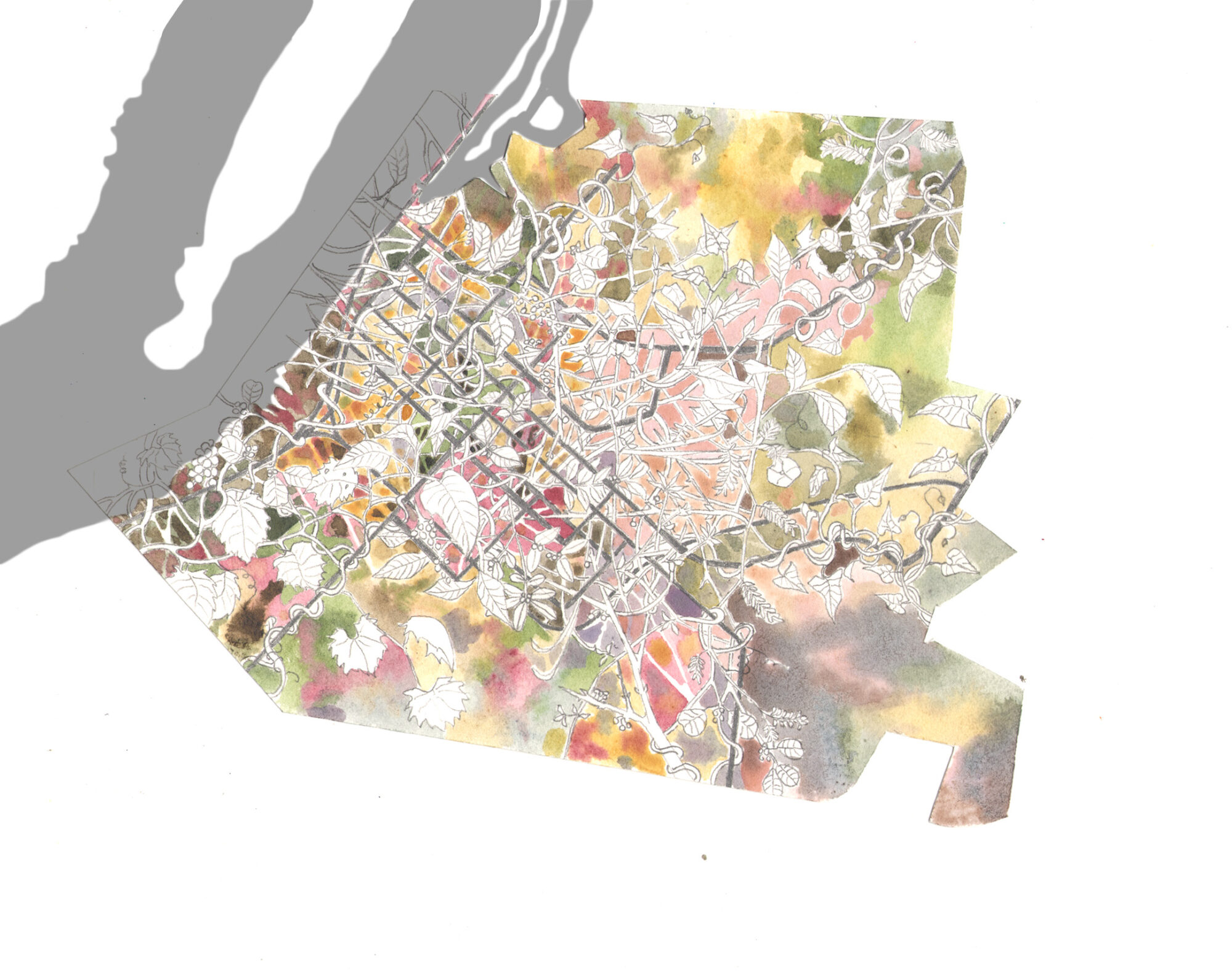

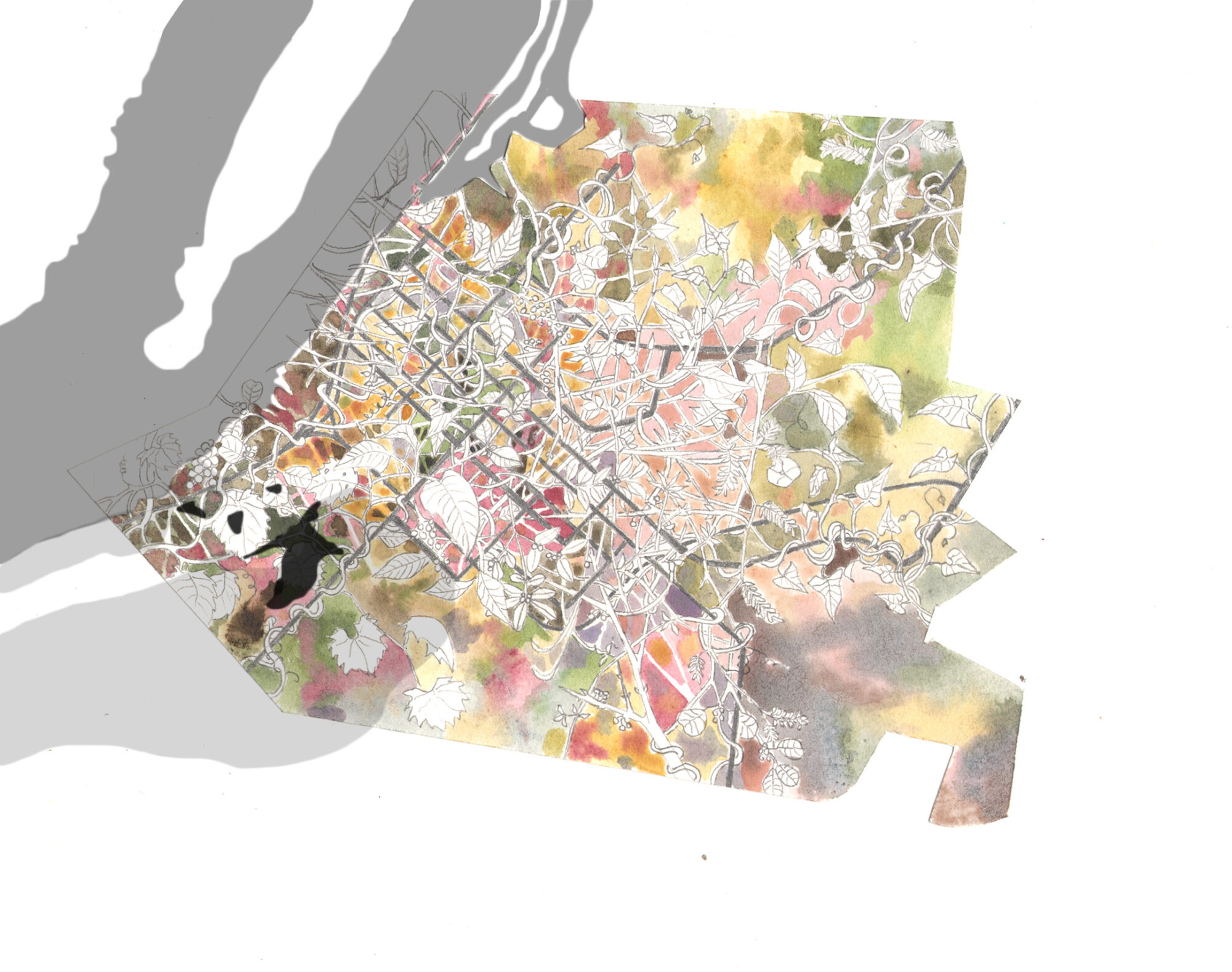

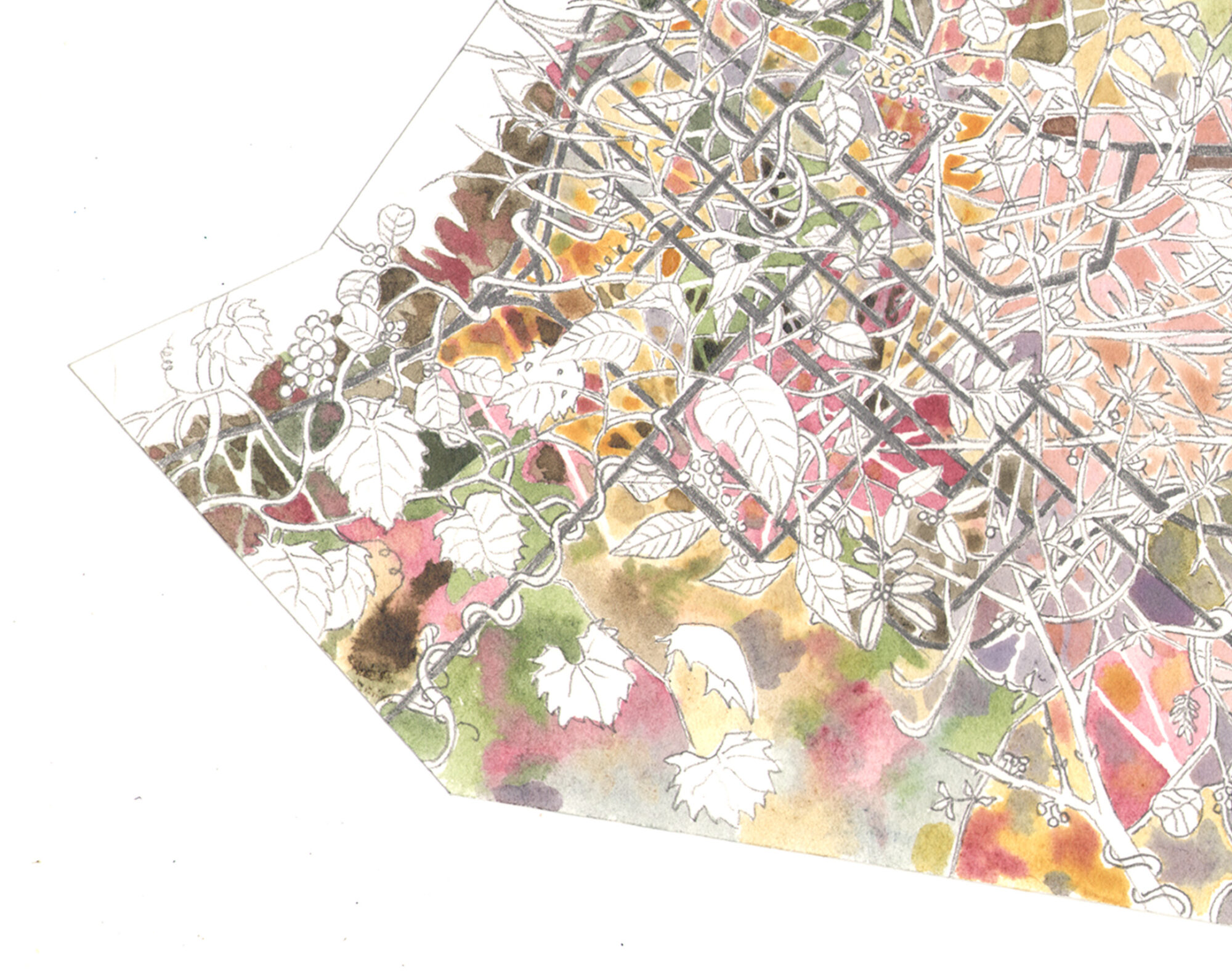
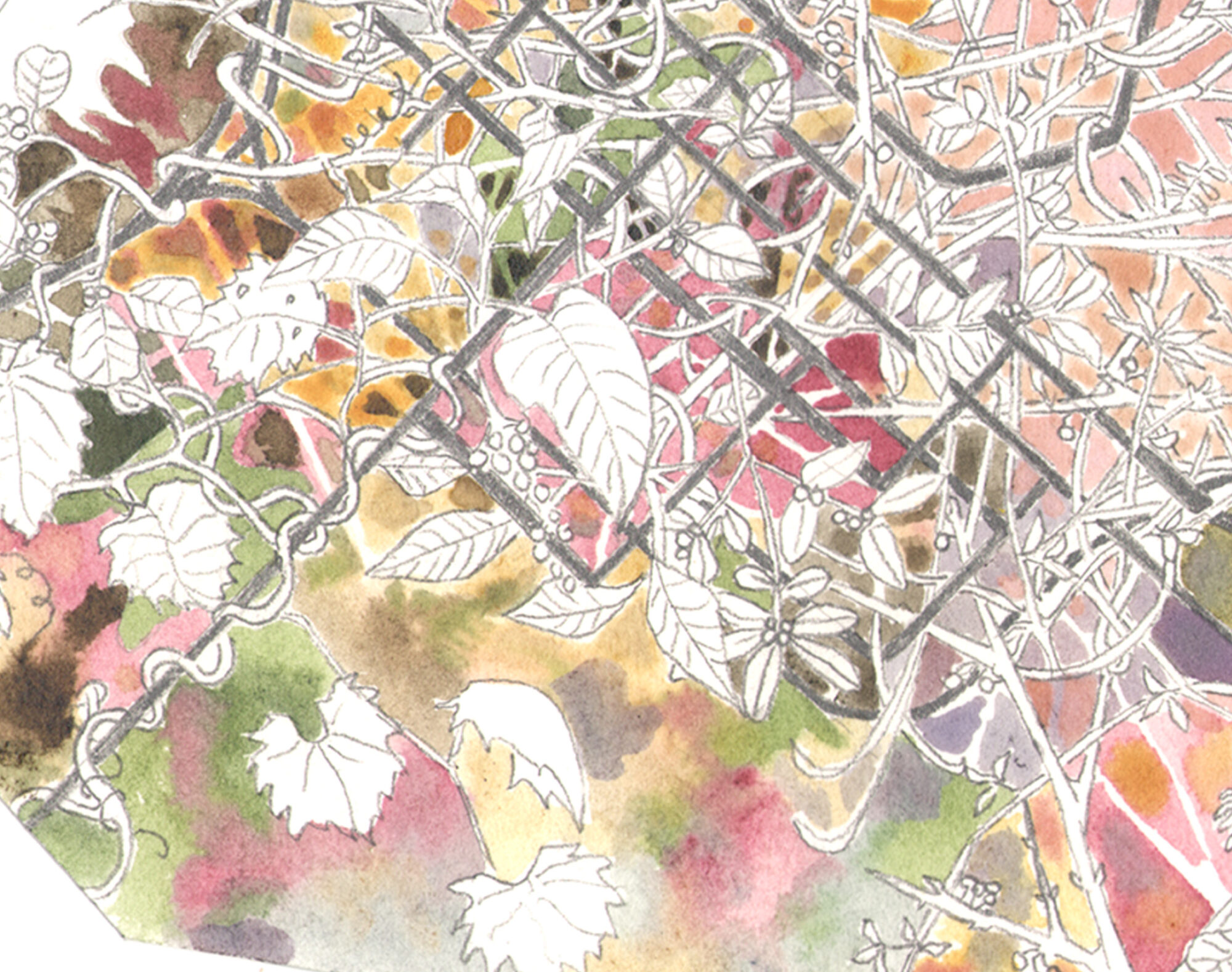
Keep scrolling for more information about this painting.
The municipal boundaries of current-day Hudson extend part way into the river on the city’s west side, and cut around unfilled marshland in the northwest corner.
The part of current-day Hudson known as the South Bay (in the lower left of this image), was just that, a water-filled bay, as late as the 18th century
Today the bay and surrounding marshes have been reduced to a few holding ponds embedded among abandoned and rehabbed warehouses, parking lots, railroad tracks, and a county correctional facility, all sited in the former floodplain.
While the plants who make up this palette of feral hues find their way into a range of habitats in current-day Hudson, all of them can be found in relatively high concentrations on the estuarial fill of the South Bay.
Depicted in this detail are riverbank grape, Asiatic bittersweet, Bell’s honeysuckle, common buckthorn, birdsfoot trefoil, multiflora rose, and pokeweed.
When processed, blended, and layered as watercolors, their pigments produce a wide range of hues. To me, this variation and blending mirrors the range of ecosocial relationships these beings build as the green the South Bay.


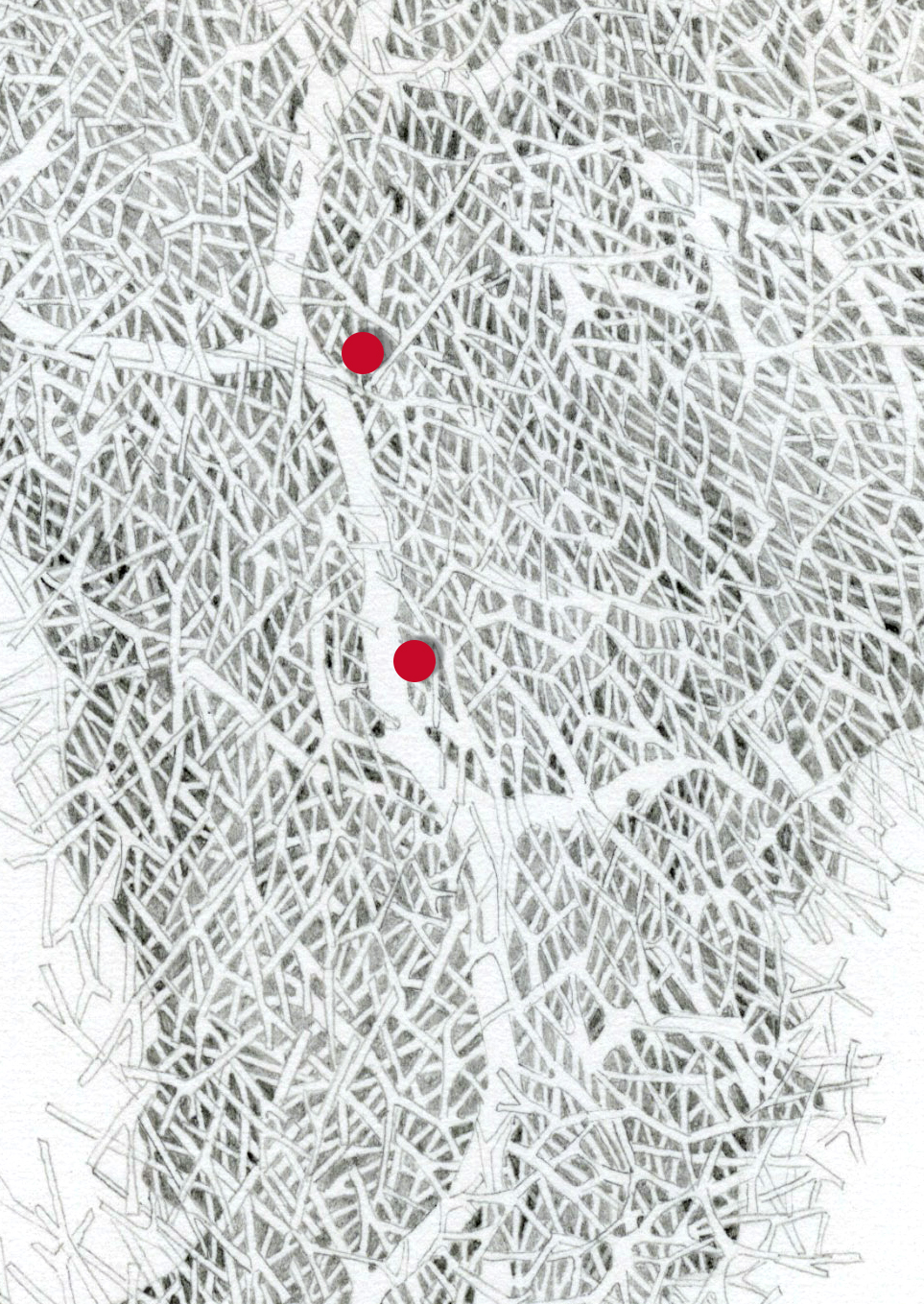
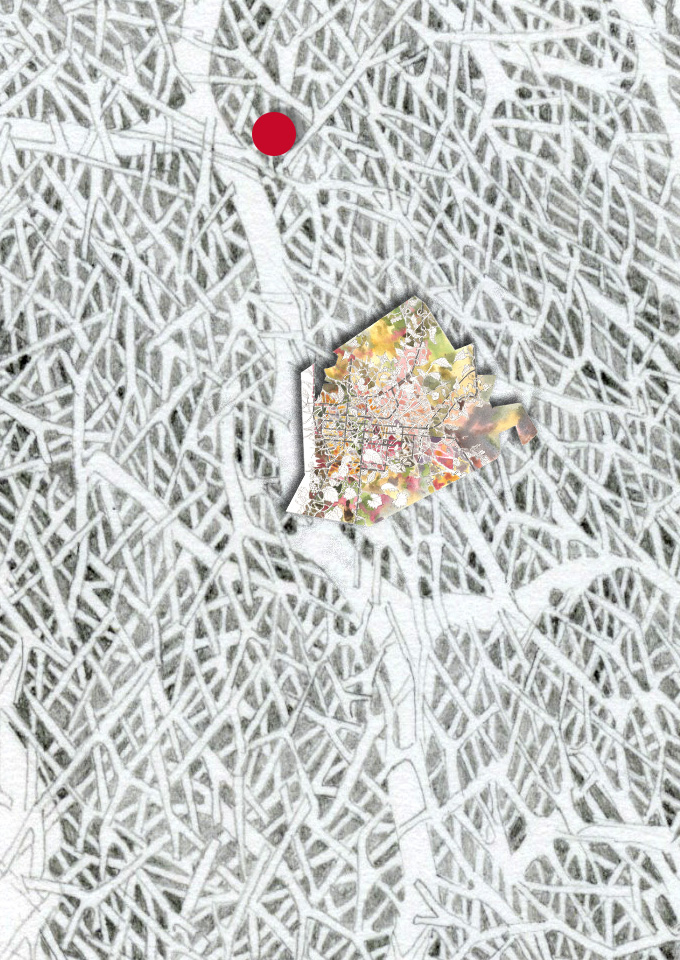
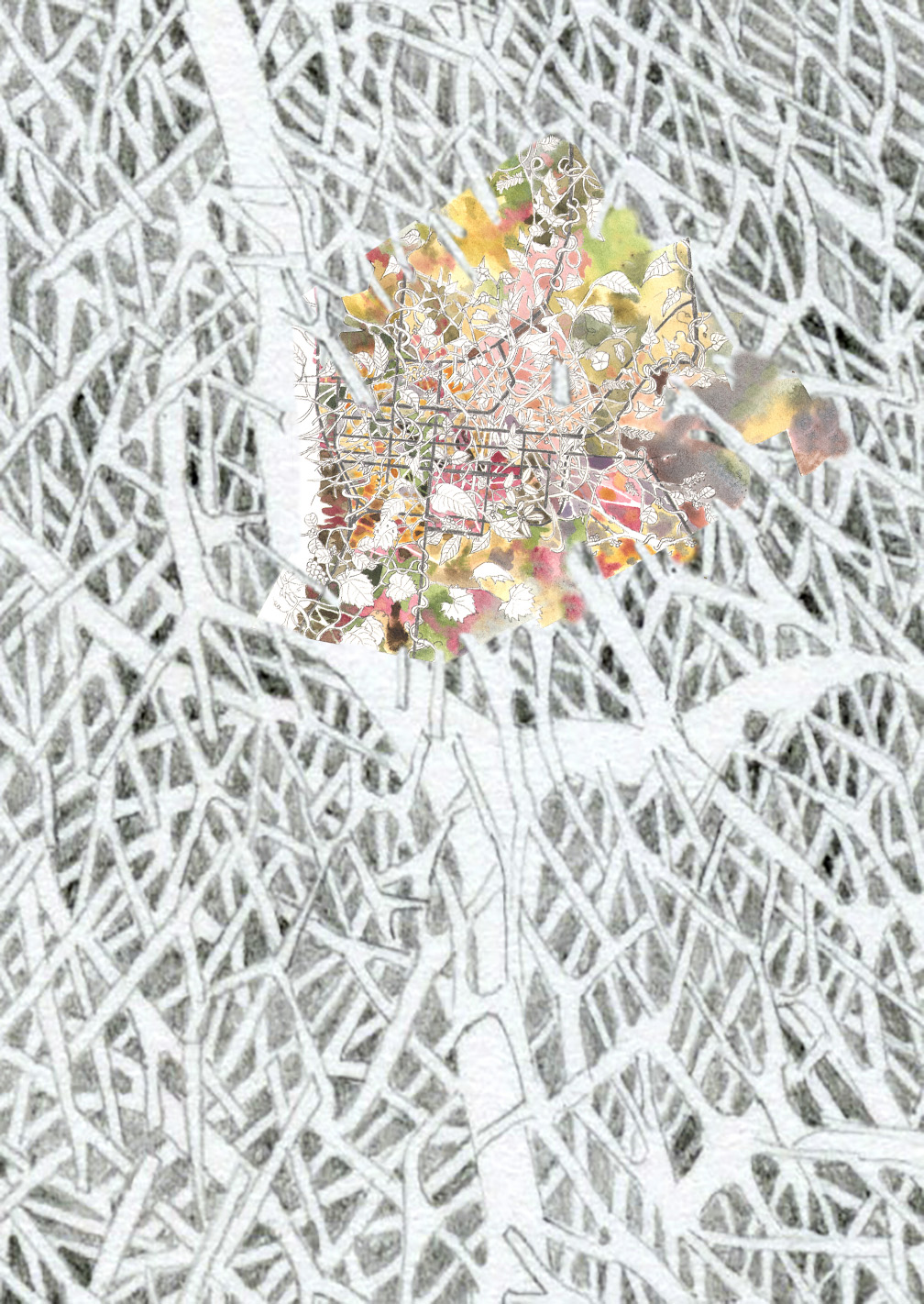
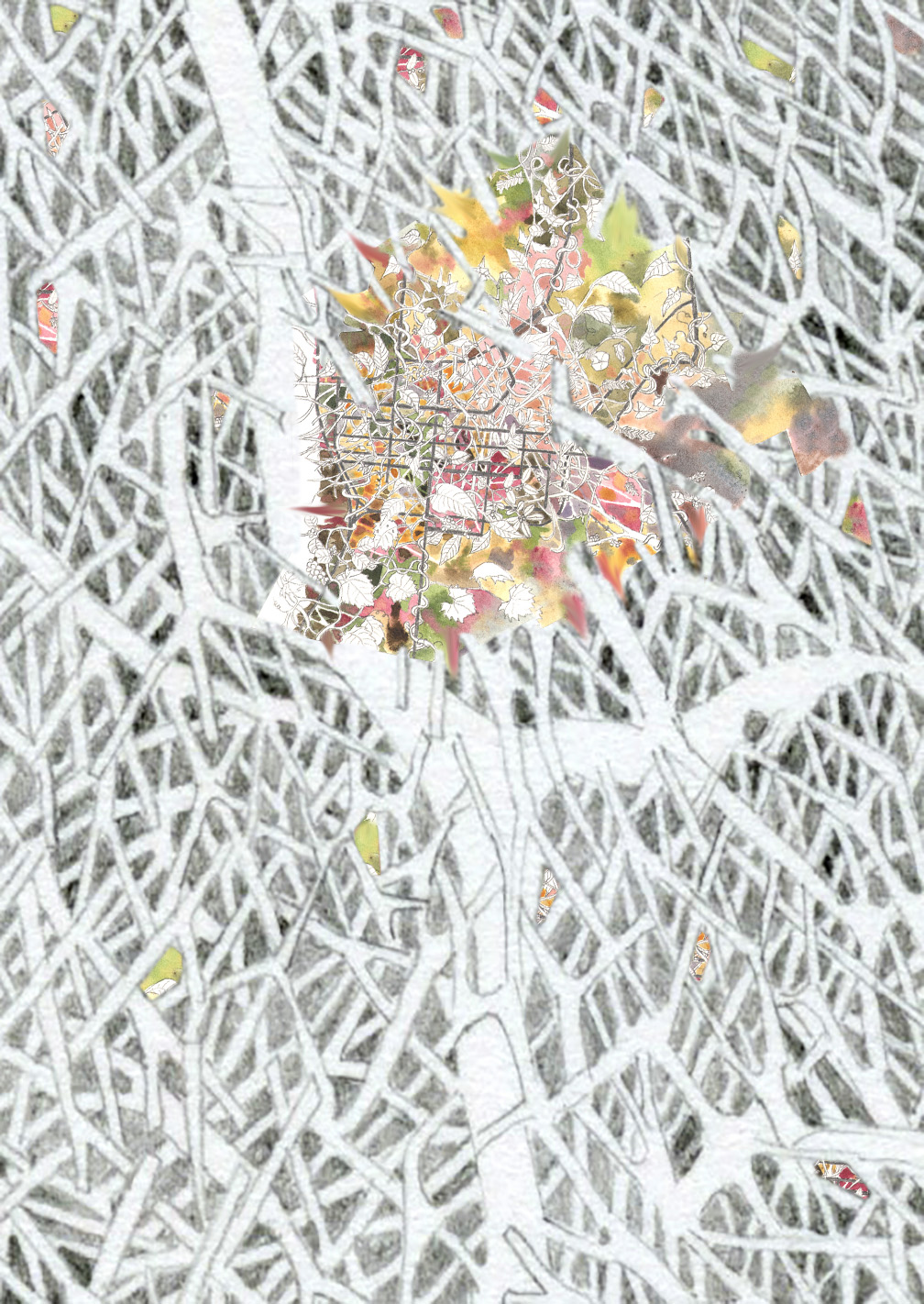
This drawing (from my Watershed Topography series) depicts the Hudson River watershed, meaning the area of land drained by the Hudson River and its tributaries.
The three red dots mark areas in the Hudson River estuary where I’ve done pigment work, including, from north to south, current-day Troy, Hudson, and Brooklyn, New York.
Current-day Troy is at the northern-most tip of the estuary, at the confluence with the Mohawk River. Here a dam and federal lock mark the start of the Erie Canal and prevent tidal flows from moving further north. Current-day Hudson is about forty miles south of the dam.
Like all waterfront towns in the Hudson River watershed, current-day Hudson, with its sharply drawn municipal boundaries, sits in the center of a complex network of ecological systems…
…including flows of water, silt, nutrients, and seeds that bind it to the greater watershed.
Layering multiple geographic structures on top of each other–including watersheds and plant habitats–helps me find relevant scales of concern and curiosity between the hyperlocal and global.
While blending and layering hues generates metaphorical and physical complexity that feels appropriate to representing the complex ecosocial systems we’re embedded in, I also get a lot of pleasure from analyzing an appreciating the individual plant pigments on their own. The chart below lays out the range of variations provided by the thirteen plants I worked with for my South Bay palette, while the burst palette painting below that allows them to blend both visually and physically without representing a specific shape or geopgraphy.
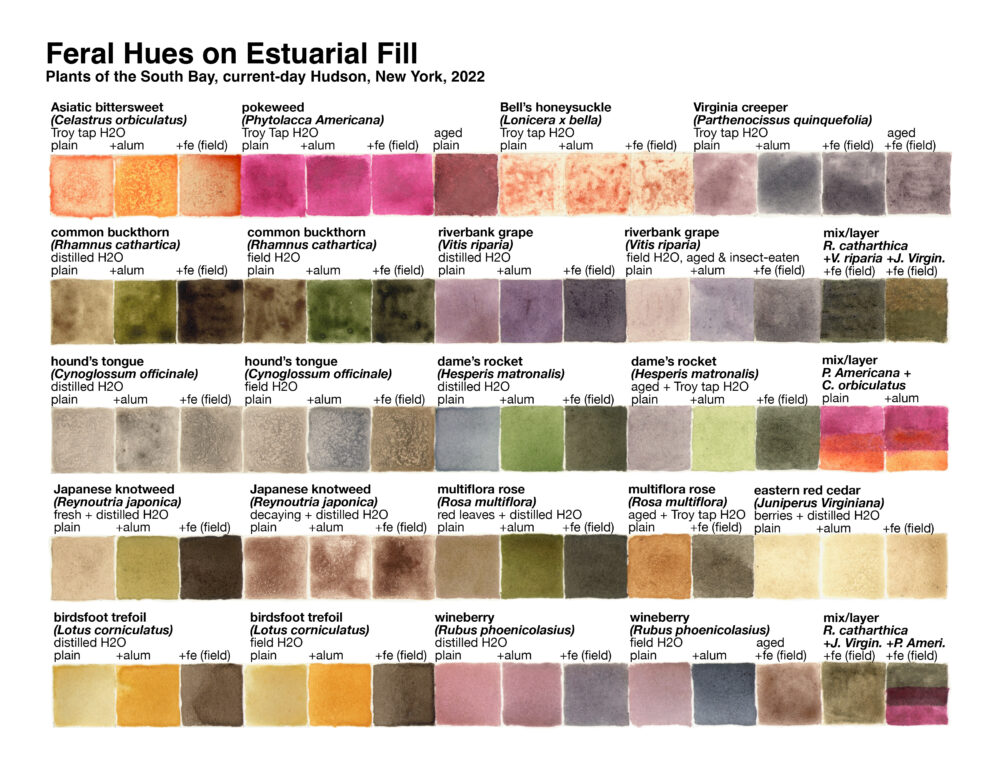
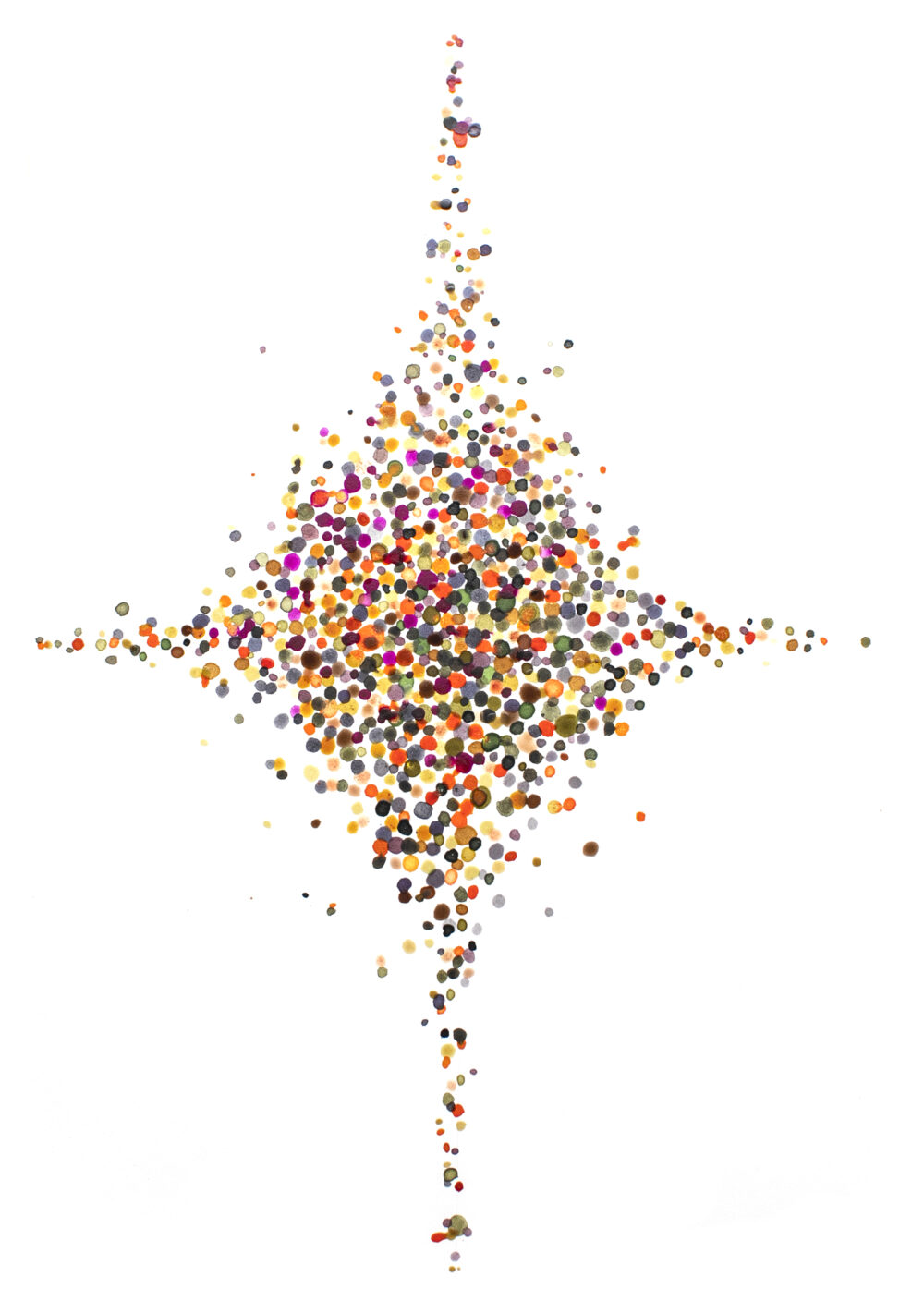
watercolor (foraged plant parts, gum Arabic, honey, mordants), 16 x 20″